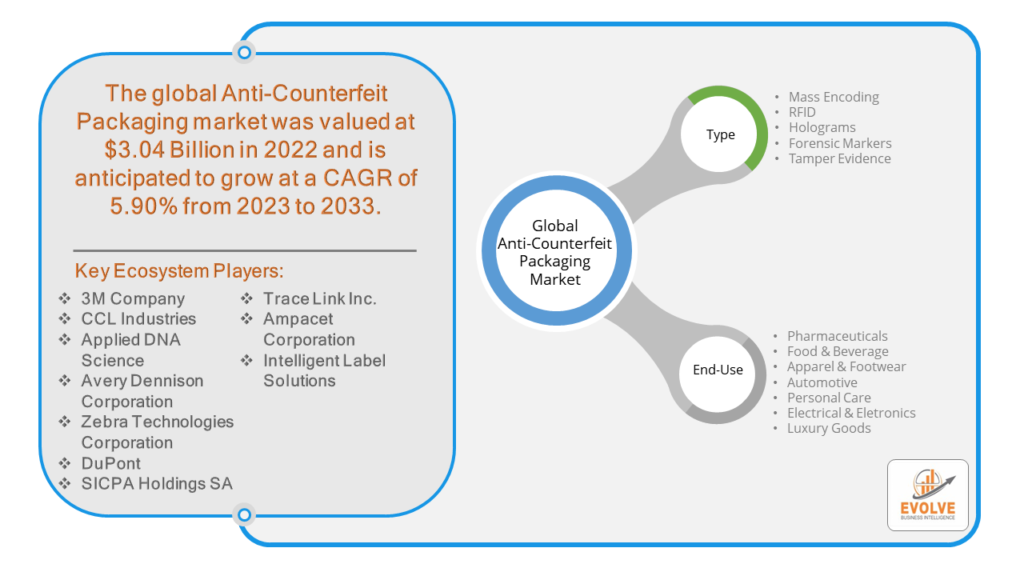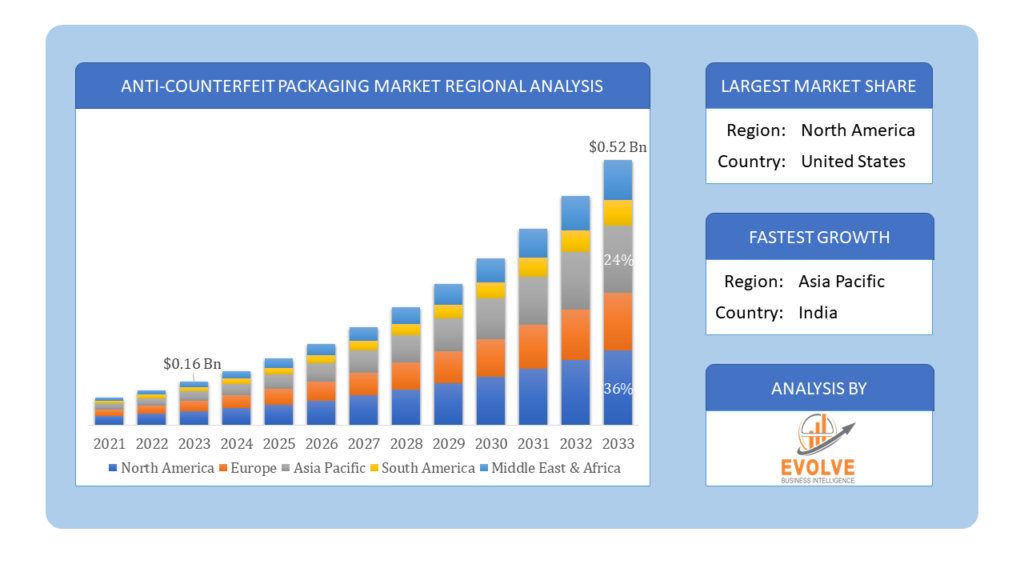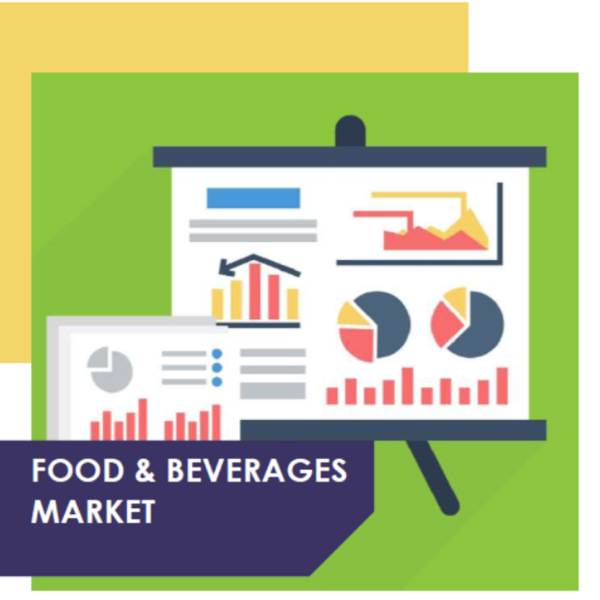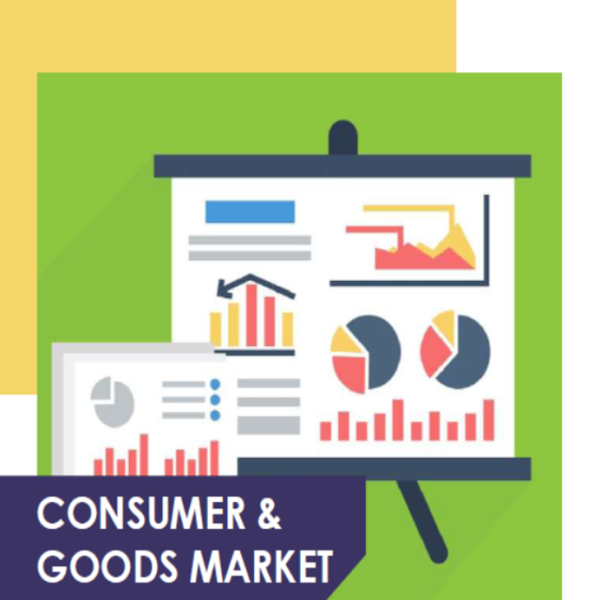Anti-Counterfeit Packaging Market Overview
The global Anti-Counterfeit Packaging market was valued at $3.04 Billion in 2022 and is anticipated to grow at a CAGR of 5.90% from 2023 to 2033. Anti-counterfeit packaging refers to the techniques and methods employed through packaging to prevent intentional tampering and ultimately to consumers. The goal is to prevent goods from being replaced or counterfeited during circulation and transfer. Anti-counterfeit packaging is mainly for sales packaging, i.e. the product packaging that needs to enter the market and be selected by consumers on shelves. For bulk industrial product packaging and transportation packaging, the meaning of anti-counterfeit packaging is relatively less. Anti-counterfeit packaging serves to protect both the interests and reputation of product manufacturers and the well-being of consumers. It acts as a deterrent against the production of fake and substandard goods. Scientific and reliable anti-counterfeit packaging promotes the application and adoption of new technologies, processes, and business concepts in product development, production, and enhancement. It provides scientific validation for the authenticity of certain products and enhances trust and security for the packaged goods. Anti-counterfeit packaging is an extension and advancement of conventional packaging, with its primary feature being to protect products from intentional harm and damage through certain covert means.
Global Anti-Counterfeit Packaging Market Synopsis
The COVID-19 pandemic significantly impacted the anti-counterfeit packaging market due to supply chain disruptions and a shortage of raw materials such as plastics, papers, labeling, and other required materials. This led to a decrease in demand for anti-counterfeit packaging in the first quarter of 2020. However, the market is expected to grow due to the packaging industry’s overall expansion, driven by the rising demand for packaging products from the food & beverage, personal care, and pharmaceutical sectors. The increasing demand for packaged products, especially in urban regions, contributes to the growth of the anti-counterfeit packaging industry. The rise of e-commerce and Direct-to-Consumer (DTC) sales channels has also created a surge in demand for packaging materials, including anti-counterfeit packaging, to ensure product information, safety, and authenticity.
Anti-Counterfeit Packaging Market Dynamics
The major factors that have impacted the growth of Anti-Counterfeit Packaging are as follows:
Drivers:
Ø Technological Advancements
With advancements in technology, innovative anti-counterfeit solutions such as holograms, RFID tags, tamper-evident seals, and QR codes have become more accessible and cost-effective. These technologies drive the adoption of anti-counterfeit packaging by offering reliable and scalable solutions.
Restraint:
- Privacy Concerns
Certain anti-counterfeit technologies, such as RFID tags or serialization codes, raise privacy concerns related to data collection and tracking. Companies must address these privacy concerns and ensure compliance with data protection regulations while implementing anti-counterfeit measures.
Opportunity:
⮚ Innovation and Technology Advancement
The need for more robust anti-counterfeit measures drives innovation in packaging technologies and security features. Opportunities exist for the development of novel solutions, such as smart packaging, DNA tagging, blockchain-based authentication, and machine-readable codes, to enhance product security and traceability.
Anti-Counterfeit Packaging Segment Overview
By Type
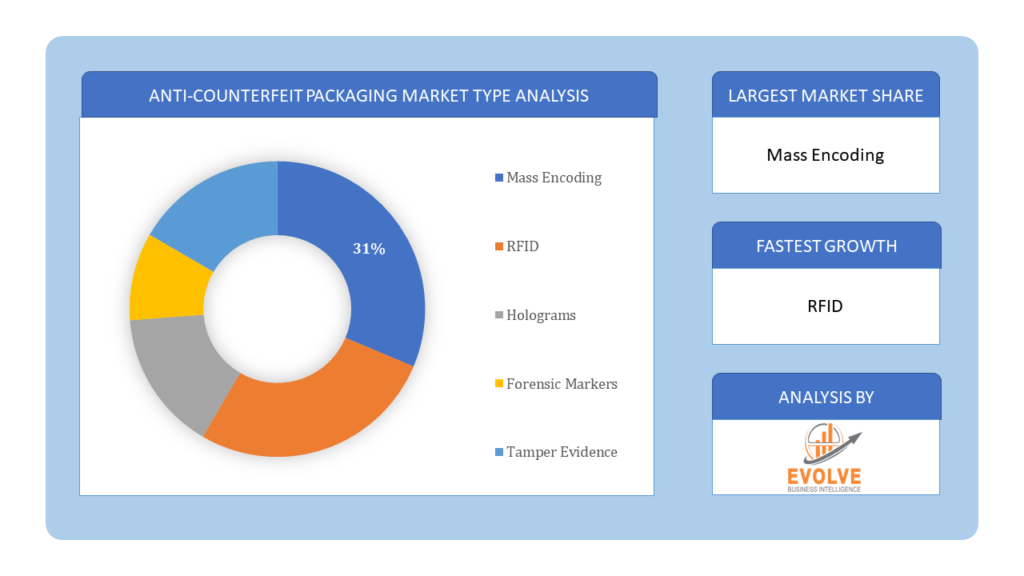 Based on Type, the market is segmented based on Mass Encoding, RFID, Holograms, Forensic Markers and Tamper Evidence. In 2021, the anti-counterfeit packaging industry grew significantly in the mass encoding category. The product tracking solution provided by mass encoding technology through the multiple supply chain and logistics nodes is primarily responsible for its market domination.
Based on Type, the market is segmented based on Mass Encoding, RFID, Holograms, Forensic Markers and Tamper Evidence. In 2021, the anti-counterfeit packaging industry grew significantly in the mass encoding category. The product tracking solution provided by mass encoding technology through the multiple supply chain and logistics nodes is primarily responsible for its market domination.
By End Use
Based on End Use, the market has been divided into the Pharmaceuticals, Food & Beverage, Apparel & Footwear, Automotive, Personal Care, Electrical & Eletronics and Luxury Goods. In 2021, the pharmaceuticals segment held the greatest proportion of the market. Increased awareness of anti-counterfeit packaging and human health and safety is one of the causes driving the rise in demand for anti-counterfeiting technologies in packaging.
Global Anti-Counterfeit Packaging Market Regional Analysis
Based on region, the global Anti-Counterfeit Packaging market has been divided into North America, Europe, Asia-Pacific, the Middle East & Africa, and Latin America. North America is projected to dominate the use of the Anti-Counterfeit Packaging market followed by the Asia-Pacific and Europe regions.
 Anti-Counterfeit Packaging North America Market
Anti-Counterfeit Packaging North America Market
North America holds a dominant position in the Anti-Counterfeit Packaging Market. North America dominated the market share in 2021. The anti-counterfeit packaging sector in North America is driven mostly by government measures to combat the counterfeit market in the United States and Canada. Product traceability is critical because consumers desire greater accessibility. Anti-counterfeiting regulations have helped it boost its market share. Manufacturers are progressively integrating new technology into machines to facilitate item identification and tracking.
Anti-Counterfeit Packaging Asia-Pacific Market
The Asia-Pacific region has indeed emerged as the fastest-growing market for the Anti-Counterfeit Packaging industry. Asia-Pacific had the quickest market growth rate in 2021 because firms are always developing new procedures to assure product integrity while adhering to tight health and safety regulations. For example, many pharmaceutical companies manufacture their products in China, prompting the country to take a more proactive approach to protecting customers from food and medical device fraud and counterfeit drugs. It implies that it is more critical than ever to be aware of product authenticity and anti-counterfeiting technologies such as barcodes, holograms, labeling, and RFIDs..
Competitive Landscape
The global Anti-Counterfeit Packaging market is highly competitive, with numerous players offering a wide range of software solutions. The competitive landscape is characterized by the presence of established companies, as well as emerging startups and niche players. To increase their market position and attract a wide consumer base, the businesses are employing various strategies, such as product launches, and strategic alliances.
Prominent Players:
- 3M Company
- CCL Industries
- Applied DNA Science
- Avery Dennison Corporation
- Zebra Technologies Corporation
- DuPont
- SICPA Holdings SA
- Trace Link Inc
- Ampacet Corporation
- INTELLIGENT LABEL SOLUTIONS
Key Development
In September 2022, 3M Company introduced a breakthrough anti-counterfeit packaging solution leveraging advanced nanotechnology, enhancing product authentication and security. This innovative offering provided a cost-effective and scalable approach for brands to protect their products from counterfeit activities while ensuring consumer confidence and brand integrity.
Scope of the Report
Global Anti-Counterfeit Packaging Market, by type
- Mass Encoding
- RFID
- Holograms
- Forensic Markers
- Tamper Evidence
Global Anti-Counterfeit Packaging Market, by end-use
- Pharmaceuticals
- Food & Beverage
- Apparel & Footwear
- Automotive
- Personal Care
- Electrical & Eletronics
- Luxury Goods
Global Anti-Counterfeit Packaging Market, by Region
- North America
- US
- Canada
- Mexico
- Europe
- UK
- Germany
- France
- Italy
- Spain
- Benelux
- Nordic
- Rest of Europe
- Asia Pacific
- China
- Japan
- South Korea
- Indonesia
- Austalia
- Malaysia
- India
- Rest of Asia Pacific
- South America
- Brazil
- Argentina
- Rest of South America
- Middle East & Africa
- Saudi Arabia
- UAE
- Egypt
- South Africa
- Rest of Middle East & Africa
| Parameters | Indicators |
|---|---|
| Market Size | 2033: $3.04 Billion |
| CAGR | 5.90% CAGR (2023-2033) |
| Base year | 2022 |
| Forecast Period | 2023-2033 |
| Historical Data | 2021 |
| Report Coverage | Revenue Forecast, Competitive Landscape, Growth Factors, and Trends |
| Key Segmentations | Type, End Use |
| Geographies Covered | North America, Europe, Asia-Pacific, Latin America, Middle East, Africa |
| Key Vendors | 3M Company, CCL Industries, Applied DNA Science, Avery Dennison Corporation, Zebra Technologies Corporation, DuPont, SICPA Holdings SA, Trace Link Inc, Ampacet Corporation, INTELLIGENT LABEL SOLUTIONS |
| Key Market Opportunities | • Growth in emerging economies |
| Key Market Drivers | • Increase in the number of counterfeit products |
REPORT CONTENT BRIEF:
- High-level analysis of the current and future Anti-Counterfeit Packaging market trends and opportunities
- Detailed analysis of current market drivers, restraining factors, and opportunities in the future
- Anti-Counterfeit Packaging market historical market size for the year 2021, and forecast from 2023 to 2033
- Anti-Counterfeit Packaging market share analysis at each product level
- Competitor analysis with detailed insight into its product segment, Government & Defense strength, and strategies adopted.
- Identifies key strategies adopted including product launches and developments, mergers and acquisitions, joint ventures, collaborations, and partnerships as well as funding taken and investment done, among others.
- To identify and understand the various factors involved in the global Anti-Counterfeit Packaging market affected by the pandemic
- To provide a detailed insight into the major companies operating in the market. The profiling will include the Government & Defense health of the company’s past 2-3 years with segmental and regional revenue breakup, product offering, recent developments, SWOT analysis, and key strategies.


